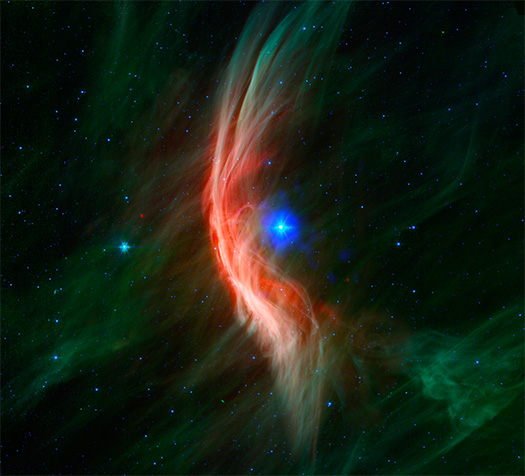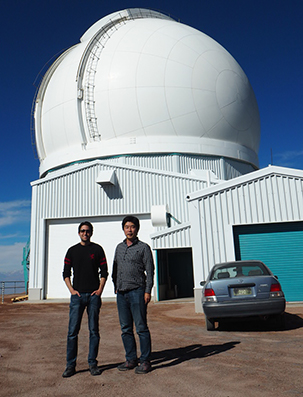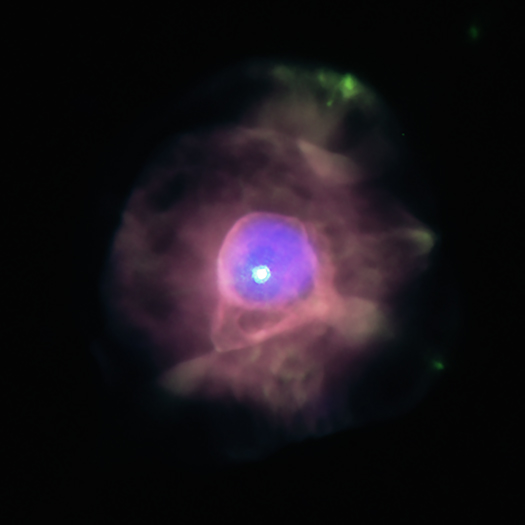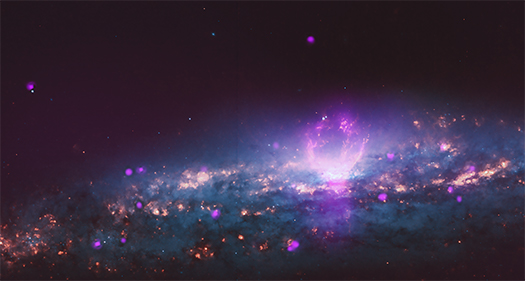Normal Stars & Star Clusters
Planets Can Be Anti-Aging Formula for Stars
An artist’s illustration shows a gas giant planet (lower right) closely orbiting its host star (left), with another star in the distance (upper right). The two stars are themselves in orbit with each other. As explained in our latest press release, a team of scientists used NASA’s Chandra X-ray Observatory and ESA’s XMM-Newton to test whether such exoplanets (known as “hot Jupiters”) affect their host star in comparison to the star that does not have one. The results show that these exoplanets can make their host star act younger than it is by causing the star to spin more quickly than it would without such a planet.
The double-star (or “binary”) system in the illustration is one of dozens that astronomers studied using Chandra and XMM-Newton to look for the effects of hot Jupiters on their host stars. A hot Jupiter can potentially influence its host star by tidal forces, causing the star to spin more quickly than if it did not have such a planet. This more rapid rotation can make the host star more active and produce more X-rays, making it appear younger than it really is.
Embracing a Rejected Star

Zeta Ophiuchi
Credit: X-ray: NASA/CXC/Dublin Inst. Advanced Studies/S. Green et al.; Infrared: NASA/JPL/Spitzer
Zeta Ophiuchi is a star with a complicated past, having likely been ejected from its birthplace by a powerful stellar explosion. A new look by NASA's Chandra X-ray Observatory helps tell more of the story of this runaway star.
Located about 440 light-years from Earth, Zeta Ophiuchi is a hot star that is 20 times more massive than the Sun. Previous observations have provided evidence that Zeta Ophiuchi was once in close orbit with another star, before being ejected at about 100,000 miles per hour when this companion was destroyed in a supernova explosion over a million years ago. Previously released infrared data from NASA's now-retired Spitzer Space Telescope, seen in this new composite image, reveals a spectacular shock wave (red and green) that was formed by matter blowing away from the star's surface and slamming into gas in its path. Data from Chandra shows a bubble of X-ray emission (blue) located around the star, produced by gas that has been heated by the effects of the shock wave to tens of millions of degrees.
Eta Carinae: Visualization Explores A Massive Star's Great Eruption
Your browser does not support the video tag.
![]() More videos and information
More videos and information
Video Credit: J. Olmsted, D. Player, L. Hustak, A. Pagan, J. DePasquale, G. Bacon, F. Summers (STScI), R. Hurt (Caltech/IPAC), NASA, ESA; Music: "Sleepy Frieda", Maarten Schellekens, CC BY-NC 4.0; Image Credit: A. Fujii, J. Morse (BoldlyGo Inst), N. Smith (U Arizona), Hubble SM4 ERO Team, NASA, ESA, STScI, JPL-Caltech, CXC, ESO, NOAO, AURA, NSF
Eta Carinae, or Eta Car, is famous for a brilliant and unusual outburst, called the "Great Eruption", observed in the 1840s. This visualization presents the story of that event and examines the resulting multiwavelength emissions and three-dimensional structures surrounding Eta Car today.
Massive stars are known to have major outbursts. Eta Car, one of the most massive stars known, expelled about 10% of its mass in the Great Eruption, creating a small nebula, called the Homunculus Nebula, around it. Images taken in different wavelengths of light reveal different structures, each providing more information about the outbursts of Eta Car.
For this visualization, astronomers and artists have used NASA observations to model both the close-up and wide views of this massive and eruptive star. The Hubble Space Telescope and the Chandra X-ray Observatory have observed the nested layers of gas and dust around Eta Car using visible, ultraviolet, and X-ray light, as well as in the Hydrogen alpha emission line. The Spitzer Space Telescope provides a larger view of the Carina Nebula, along with Eta Car's dominant position within this star-forming region.
X-ray Screams From Toddler Suns

Konstantin Getman
We are very happy to welcome Dr. Konstantin Getman as our guest blogger, who is also the first author of the studies featured in our latest press release. He received an honor master's degree in astronomy at Moscow State University in 1994 and his Ph.D. degree in physics and mathematics at Pushkov Institute of Terrestrial Magnetism, Ionosphere and Radiowave Propagation of the Russian Academy of Sciences (IZMIRAN) in 1999. Since 2001, he has been at the Pennsylvania State University where he is currently a research professor. His research is focused on star formation and stellar activity, about which he authored and co-authored 80 peer-reviewed publications.
The Sun is covered with magnetic field lines like an animal is covered with fur. These twisted and sheared lines store a lot of “free” energy. When solar magnetic lines of opposite polarity come close to each other, they interact, change their topology, and release free energy, causing powerful and eruptive events, that scientists call “flares”. These flare processes include acceleration of charged particles in the Sun’s upper atmosphere (called the corona), emission of large amounts of radiation in various energy bands (such as radio, microwave, optical, and X-ray), and launching of streams of plasma and magnetic field into space (called coronal mass ejections, or CMEs).
A Cosmic Amethyst in a Dying Star
On Earth, amethysts can form when gas bubbles in lava cool under the right conditions. In space, a dying star with a mass similar to the Sun is capable of producing a structure on par with the appeal of these beautiful gems.
As stars like the Sun run through their fuel, they cast off their outer layers and the core of the star shrinks. Using NASA's Chandra X-ray Observatory, astronomers have found a bubble of ultra-hot gas at the center of one of these expiring stars, a planetary nebula in our galaxy called IC 4593. At a distance of about 7,800 light years from Earth, IC 4593 is the most distant planetary nebula yet detected with Chandra.
This new image of IC 4593 has X-rays from Chandra in purple, invoking similarities to amethysts found in geodes around the globe. The bubble detected by Chandra is from gas that has been heated to over a million degrees. These high temperatures were likely generated by material that blew away from the shrunken core of the star and crashed into gas that had previously been ejected by the star.
Assessing The Habitability of Planets Around Old Red Dwarfs

Barnard's Star (GJ 699)
Credit: X-ray light curve: NASA/CXC/University of Colorado/K. France et al.;
Illustration: NASA/CXC/M. Weiss
A new study using data from NASA's Chandra X-ray Observatory and Hubble Space Telescope gives new insight into an important question: how habitable are planets that orbit the most common type of stars in the Galaxy? The target of the new study, as reported in our press release, is Barnard's Star, which is one of the closest stars to Earth at a distance of just 6 light years. Barnard's Star is a red dwarf, a small star that slowly burns through its fuel supply and can last much longer than medium-sized stars like our Sun. It is about 10 billion years old, making it twice the age of the Sun.
The authors used Barnard's Star as a case study to learn how flares from an old red dwarf might affect any planets orbiting it. This artist's illustration depicts an old red dwarf like Barnard's Star (right) and an orbiting, rocky planet (left).
Gazing at the Youngest Star From Chile

David Principe and Kenji Hamaguchi
As our guest blogger, we welcome Kenji Hamaguchi of the Center for Research and Exploration in Space Science & Technology and NASA’s Goddard Space Flight Center in Greenbelt, MD. He is part of the team that made the discovery described in our latest press release on an X-ray flare from a very young Sun-like star.
The observatory dome appeared over the hill. "Where is it standing?" I mumbled to myself. The Southern Astrophysical Research (SOAR) Telescope stands at the dead-end of a mountain ridge. The road just before the observatory has a bottleneck with steep slopes on both sides. The dome looked as if it were standing on the head of a spear. The telescope is a part of the Cerro Tololo Inter-American Observatory in Chile, along with the Gemini South observatory, and the Vera Rubin Observatory (formerly the LSST), which is now under construction. David Principe and I had come to the SOAR observatory in mid-December 2017, to take images of the extremely young star ("protostar") HOPS 383 at near-infrared wavelengths.
The observation we were undertaking was conducted in coordination with an observation of the same protostar with NASA’s Chandra X-ray Observatory. The Chandra observation aimed to find any sign of high-energy (X-ray) radiation from this newborn star. In contrast, the SOAR observation was designed to monitor the current status of an outburst from HOPS 383 that peaked in 2008. We planned to deepen the understanding of its nature by combining these two observing techniques.
A Cosmic Jekyll and Hyde

Terzan 5
Credit: X-ray: NASA/CXC/Univ. of Amsterdam/N.Degenaar, et al.; Optical: NASA, ESO/F.Ferraro
A double star system has been flipping between two alter egos, according to observations with NASA's Chandra X-ray Observatory and the National Science Foundation's Karl F. Jansky Very Large Array (VLA). Using nearly a decade and a half worth of Chandra data, researchers noticed that a stellar duo behaved like one type of object before switching its identity, and then returning to its original state after a few years. This is a rare example of a star system changing its behavior in this way.
Astronomers found this volatile double, or binary, system in a dense collection of stars, the globular cluster Terzan 5, which is located about 19,000 light years from Earth in the Milky Way galaxy. This stellar duo, known as Terzan 5 CX1, has a neutron star (the extremely dense remnant left behind by a supernova explosion) in close orbit around a star similar to the Sun, but with less mass.
Hunting for Stellar CMEs: The Chandra Success
We are pleased to welcome Costanza Argiroffi as a guest author. Costanza led the study reporting the first secure detection of a coronal mass ejection from a star other than the Sun. She is an astrophysicist from the University of Palermo, Italy, where she is from. Her main research field is the study of low-mass stars. She obtained her PhD from the University of Palermo in 2006, and during her studies spent a few months at the Smithsonian Astrophysical Observatory in Cambridge, MA. Then she worked as a postdoc and, since 2008, as a researcher at the University of Palermo.
Coronal Mass Ejections (CMEs) are large-scale expulsions of material previously confined in the atmosphere of a star. CMEs are among the most powerful magnetic phenomena occurring in the atmosphere of the Sun, reaching velocities of about 2 million miles per hour, masses of about 200,000 billion pounds, and kinetic energies equivalent to about 125 million Krakatoa eruptions.
Using data from NASA’s Chandra X-ray Observatory, we have made the first unambiguous detection of a CME by a star other than the Sun.
NGC 3079: Galactic Bubbles Play Cosmic Pinball with Energetic Particles
We all know bubbles from soapy baths or sodas. These bubbles of everyday experience on Earth are only a few inches across, and consist of a thin film of liquid enclosing a small volume of air or other gas. In space, however, there are very different bubbles — composed of a lighter gas inside a heavier one — and they can be huge.
The galaxy NGC 3079, located about 67 million light years from Earth, contains two "superbubbles" unlike anything here on our planet. A pair of balloon-like regions stretch out on opposite sides of the center of the galaxy: one is 4,900 light years across and the other is only slightly smaller, with a diameter of about 3,600 light years. For context, one light year is about 6 trillion miles, or 9 trillion kilometers.




